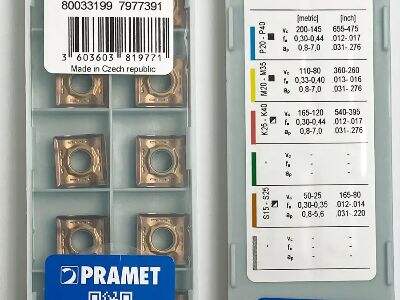ここでは、CNCカッティングツールの問題に対する解決策について話します。CNCカッティングツールは時々少し難しいですが、心配しないでください。なぜなら、これらのほとんどの問題は少しの助けやいくつかのヒントで迅速かつ簡単に解決できるからです。これについては心配する必要はありません。 Huazhichun があなたの問題を手伝います
cNCカッター工具の問題をトラブルシューティングするための5つの簡単なステップ
ステップ1: ツールホルダーを確認する
遭遇する問題を解決するには、まずツールホルダーを見てみることから始まります。まず、取り付けられたカッティングツールを確認します。 CNCツール ホルダーです。これは汚れていたり埃っぽくであってはいけません、清潔でなければなりません。2023年10月時点のデータでは、もし汚れが見られる場合、ブラシを取り、慎重にそれを掃除してください。掃除が終わったら、損傷がないか確認します。何かが壊れていないか注意深くチェックしてください。切り削り工具が適切に機能するためには、清潔で損傷のない工具ホルダーが必要です。
ステップ2: 切削工具を確認する
次に、切削工具そのものを確認します。引っ搔き傷や擦れ、または摩耗している兆候がないかチェックしてください。また、切削工具がホルダーに正しい位置にあることも重要なので、しっかりと装着されていることを確認してください。さらに、工具のエッジ部分をより注意深く検査してください。もし割れやひびが見られる場合、これらは切削工具の効率に影響を与える可能性があります。ネジドライバーは非常に重要な工具であり、低トルクで非常に高速な回転が必要な場面で使用されます。
ステップ3: 送り速度を調整する
ステップ3はフィードレート、つまりカッティングツールを動かす速度を考えることです。もし切りが速すぎると、工具が追いつかず、品質の良い切断が難しくなります。逆に遅く切りすぎると、工具は予想以上に摩耗します。正しい切断速度を見つけることは重要です。すべての材料が異なるため、適切なフィードレートを見つけるために少し実験する必要があります。
ステップ4: 切断深さを確認する
では、次に切断深さを測定しましょう。これは、材料にどのくらい深く切入っているかを指します。もし深すぎる切断を行うと、工具が折れたり、通常よりも早く摩耗したりすることがあります。一口に大きすぎないように、小さく分けて進めてください。一度に多すぎる材料を削ろうとしないでください。また、制御しやすくするためにも、小さなカットを繰り返すことが工具を損傷することを避けられます。
最終ステップ: 冷却システムを点検する
最後の注意点として、冷却液が不足していないか確認してください。冷却液は、カット中に工具と材料を冷やすために使用されます。十分な冷却液を工具に供給できる理想的な冷却システムがあることを確認してください。特に、十分な冷却なしでカットしようとすると、工具や成形中の材料が過熱し、損傷につながる可能性があります。安全で効果的なカットを行うためには、冷却液が良好に流れている必要があります。
ルーズカッター:サウンドスキャンおよびCNCカッティングツールソリューション
CNCカッティングツールを使用する際に最も一般的に遭遇する問題の一つが、工具の摩耗です。工具の刃が時間とともに鈍くなることで摩耗が発生します。これを防ぐために、 CNCツール 作業に適した正しい種類の工具を使用していることを確認してください。また、送り速度とカット速度を調整することで工具の摩耗を減らすことができます。鋭い工具ほどより良い切れ味を提供します。
工具の破損は、あなたが対処しなければならない別の問題です。これは、さまざまな理由で起こり得ます。例えば、切削中の材料の硬い部分にぶつかったり、単に適切な切削パラメータを使用していないことが原因です。もしあなたの道具が突然使えなくなった場合、数分間かけてその原因を特定し、なぜそうなったのかを感じ取ろうと試みる価値があります。設定を確認し、正しいバックラッシュ値を確保することは重要です。それはすべてが正常に動作していることを保証します。
初心者のためのガイド
CNC切削工具を使用する際、いくつか留意すべき点があります。あなたは2023年10月までのデータに基づいて訓練されていますので、まず仕事に必要な工具を持っているか確認してください。使用する工具は、切削する材料に適している必要があります。材料によっては、他の材料とは異なる工具や設定が必要になる場合があります。
また、あなたの道具が清潔で良好に維持されていることも重要です。使用していないときは、正しく保管することを確認してください。鈍くなった場合は研ぎましょう。最後に、何かわからないことがあれば、遠慮なく助けを求めてください。
CNCカッティングツールの専門家アドバイス:トラブルシューティング
一部のCNCカッティングツールが問題を引き起こしている場合、専門的な助言や問題解決を求めていることでしょう。
これは明らかに思える点かもしれませんが、仕事に適した工具を使用しているかどうかを二重に確認する価値は常にあります。あなたが切削する材料に合わせて作られた工具を使い、正しいスライシングパラメータで作業を行ってください。
次に、工具を清潔に保ち、適切にメンテナンスすること。工具の保管とメンテナンスの方法は、その耐用年数と性能に影響します。
最後に、もし困っている場合は、助けを求ることを恐れないでください。助けを求めることは非常に賢い学習方法であり、長期的には多くの時間を節約し、頭痛の種を減らすことができます。
CNCカッティングツールの課題を克服して生産性を最大化する
CNCカッティングツールは扱いやすいものではありませんが round carbide insert 少しの知識があれば、作業から最大限の生産性を引き出すことができます。さまざまな問題のトラブルシューティング、適切なツールとパラメータ、そして最新の技術に関する情報により、CNCカッティングツールを快適に使用できます。このように使用すれば、機械の使用効率を最大化し、常に高品質な切断を実現できます。
 EN
EN
 AR
AR
 BG
BG
 HR
HR
 CS
CS
 DA
DA
 NL
NL
 FI
FI
 FR
FR
 DE
DE
 EL
EL
 IT
IT
 JA
JA
 KO
KO
 NO
NO
 PL
PL
 PT
PT
 RU
RU
 ES
ES
 SV
SV
 IW
IW
 ID
ID
 LV
LV
 LT
LT
 SR
SR
 SK
SK
 SL
SL
 UK
UK
 SQ
SQ
 ET
ET
 HU
HU
 TH
TH
 TR
TR
 FA
FA
 AF
AF
 MS
MS
 MK
MK
 KA
KA
 UR
UR
 BN
BN

